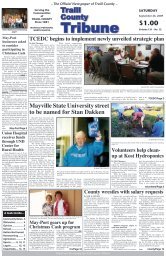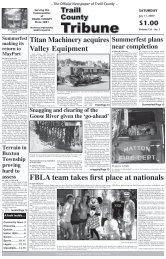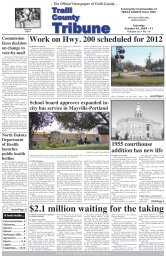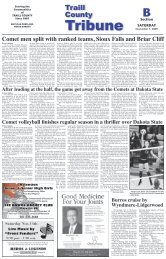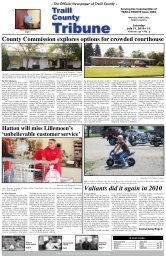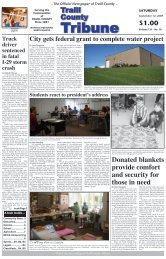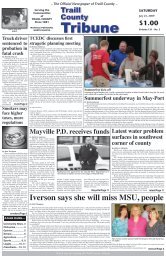October 10, 2009 - Traill County Tribune
October 10, 2009 - Traill County Tribune
October 10, 2009 - Traill County Tribune
You also want an ePaper? Increase the reach of your titles
YUMPU automatically turns print PDFs into web optimized ePapers that Google loves.
Page 8 • <strong>October</strong> <strong>10</strong>, <strong>2009</strong> AGRICULTURE <strong>Traill</strong> <strong>County</strong> <strong>Tribune</strong><br />
Extension Notes<br />
Kendall Nichol<br />
North Dakota State University<br />
Extension Agent<br />
<strong>Traill</strong> <strong>County</strong><br />
Digging and storing flower bulbs<br />
Many of the tender flower bulbs<br />
such as gladiolus, cannas, dahlias and<br />
tuberous begonias require special<br />
care to assure good condition the following<br />
spring. Todd Weinmann, Cass<br />
<strong>County</strong> Horticulturalist has provided<br />
the following tips.<br />
Gladiolus are the main type of<br />
bulb to be discussed. Dig the bulb<br />
(corm) after the first frost and cut<br />
the tops off flush with the top of the<br />
corm. Spread the bulbs in a dry, frostfree<br />
place for 2-3 weeks. After curing,<br />
the old shriveled corms and roots<br />
should snap off cleanly. Those that<br />
do not clean readily are either insufficiently<br />
cured or diseased; the latter is<br />
often detected by discoloration of the<br />
husks. After cleaning, dust the bulbs<br />
by shaking in a paper bag with 5%<br />
Sevin Dust (1-2 teaspoons for each<br />
<strong>10</strong>0 corms). Then store in shallow<br />
boxes on a basement floor or on low<br />
shelves.<br />
After a frost, the dahlia, canna,<br />
and tuberous begonia root clumps<br />
should be carefully lifted with a spading<br />
fork. Shake off the greater part of<br />
the soil and cut off the tops at ground<br />
level. Tuberous begonia tops should<br />
be removed close to the tuber. Dry<br />
the clump well but not to the point<br />
that any shriveling of the roots is<br />
noticed. Place the cured clump in a<br />
large plastic bag (without holes) and<br />
tie securely. Do not divide the clump<br />
until next spring. Store in the coolest,<br />
frost-free place that you have in your<br />
home (34-40 degrees is ideal). Inspect<br />
occasionally for signs of mold which<br />
may occur, if drying was insufficient.<br />
If mold occurs, open the bag temporarily<br />
and allow the drying.<br />
If you have any questions concerning<br />
the harvest and storage of<br />
flower bulbs, contact Kendall Nichols<br />
at the <strong>Traill</strong> <strong>County</strong> Extension Office<br />
at 701-636-5665.<br />
NDSU to study variablerate<br />
fertilization<br />
Producers are invited to participate<br />
in a research demonstration project to<br />
investigate the effects of variable-rate<br />
fertilization on crop yields, according<br />
to John Nowatzki, North Dakota State<br />
University agricultural machine systems<br />
specialist.<br />
“Increasingly, farmers are purchasing<br />
equipment capable of applying<br />
variable rates of fertilizer, but many<br />
farmers are reluctant to incorporate this<br />
practice,” Nowatzki says. “It could be<br />
because there is little whole-field research<br />
available to evaluate its effectiveness.<br />
The most obvious reason to<br />
use variable-rate fertilization is to decrease<br />
input costs per unit of harvested<br />
crop.”<br />
Northern Plains crop producers are<br />
invited to participate in the program<br />
with up to four fields each. Each field<br />
will be analyzed separately, but then<br />
combined into a single database to<br />
evaluate the effectiveness of variablerate<br />
fertilization. Interested individuals<br />
can contact Nowatzki by e-mail at john.<br />
nowatzki@ndsu.edu or call (701) 231-<br />
8213 for more detailed information.<br />
Variable-rate fertilizer application<br />
allows crop producers to apply different<br />
rates of fertilizer at various locations<br />
across fields. The technology needed to<br />
do variable-rate fertilization includes<br />
an in-cab computer with a field zone<br />
application map, fertilizing equipment<br />
capable of changing rates during operation<br />
and a global positioning system<br />
(GPS) receiver.<br />
The in-cab computer uses GPS to<br />
monitor its position in the field and<br />
communicates electronically with the<br />
rate controller on the application equipment<br />
to change the fertilizer rate as the<br />
equipment moves from one zone to the<br />
next.<br />
The number of zones in each field<br />
is determined by the variability within<br />
each field. More uniform field conditions<br />
require fewer zones. Zone soil<br />
sampling determines the residual nutrients<br />
available for the next crop. This information<br />
is used with crop yield goals<br />
to select the amount of fertilizer to apply<br />
in each management zone.<br />
Zone maps are made using a geographic<br />
information system (GIS) computer<br />
program to combine field variability<br />
information to delineate field<br />
areas based on productivity levels.<br />
“Several factors contribute to field<br />
variability including topography, soil<br />
physical and chemical properties, cropping<br />
history, historical cropping patterns<br />
and field uses,” Nowatzki says.<br />
“A regional project in North Dakota,<br />
Montana and Minnesota concluded that<br />
a variety of factors can be used to develop<br />
zones, but topography, remotely<br />
sensed images of previous year’s crops<br />
and historical crop yield data revealed<br />
the highest correlation to crop productivity.”<br />
For this project, Nowatzki plans<br />
to use the Web-based zone mapping<br />
tool ZoneMap (http://zonemap.umac.<br />
org/) to prepare the field zone and application<br />
maps. It was developed and<br />
is maintained by the Upper Midwest<br />
Aerospace Consortium at the University<br />
of North Dakota. ZoneMap allows<br />
users to use historical satellite imagery<br />
and their own yield and soil test data to<br />
delineate zone maps and download fertilizer<br />
application maps.<br />
Project participants will be required<br />
to soil test each zone separately.<br />
The producer will select the crop and<br />
yield goal. To compare the crop yield<br />
between variable rate and the normal<br />
practice of applying one fertilizer rate<br />
across the entire field, random sections<br />
of each zone will have fertilizer applied<br />
based on a composite soil test from all<br />
soil samples.<br />
Nowatzki will use the as-applied<br />
fertilizer application maps and crop<br />
yield monitor data from a GIS computer<br />
program to analyze the data.<br />
Participant requirements include<br />
supplying the geographic field description,<br />
cropping history, planned crop and<br />
yield goal for each field; soil sampling<br />
and testing of each zone; testing a composite<br />
soil sample; doing the variablerate<br />
fertilization; sharing the as-applied<br />
map; harvesting the crop with a yield<br />
monitor; and sharing the yield data.<br />
NDSU will prepare zone and fertilizer<br />
application maps, provide the maps<br />
to the producers in their desired digital<br />
format and analyze the data at the end<br />
of the growing season.<br />
Citizens asked to help decide<br />
state’s noxious weeds<br />
The North Dakota Department of<br />
Agriculture is asking state residents to<br />
take part in a survey to help determine<br />
what plants should be declared noxious<br />
weeds.<br />
“I wouldn’t call it a popularity contest,<br />
but we very much want to know<br />
which weeds people think are the biggest<br />
problem here,” said Agriculture<br />
Commissioner Doug Goehring. “The<br />
noxious weed designation is important<br />
because the lion’s share of weed control<br />
funds go toward noxious weeds, and<br />
failure to control noxious weeds can be<br />
a Class B misdemeanor.”<br />
A link to the survey can be found on<br />
the homepage of the department Web<br />
site, www.agdepartment.com. The survey<br />
will be open until Nov. 1.<br />
Survey participants will be asked to<br />
check the weeds they think should be<br />
on the noxious weeds list. The choices<br />
include absinth wormwood, baby’s<br />
breath, black henbane, false chamomile,<br />
scentless chamomile, common<br />
burdock, common tansy, dame’s rocket,<br />
downy brome, field bindweed, hoary<br />
cress, houndstongue, Russian knapweed,<br />
spotted knapweed, diffuse knapweed,<br />
kochia, leafy spurge, common<br />
milkweed, orange hawkweed, poison<br />
ivy, purple loosestrife, annual sowthistle,<br />
perennial sowthistle, St. Johnswort,<br />
bull thistle, Canada thistle, musk thistle,<br />
plumeless thistle, Scotch thistle, wavy<br />
thistle, Dalmatian toadflax, yellow<br />
toadflax and yellow starthistle. Participants<br />
can also write in other weeds.<br />
The survey also asks participants<br />
how many weeds should be on the list<br />
and if domesticated varieties of noxious<br />
weeds, such as purple loosestrife<br />
and baby’s breath, should be included<br />
on the list.<br />
The survey results are not binding.<br />
A noxious weed is a plant determined<br />
by the commissioner, a county<br />
or city weed board to be injurious to<br />
public health, crops, livestock, land, or<br />
other property. North Dakota’s noxious<br />
weeds now include absinth wormwood,<br />
Canada thistle, Dalmatian toadflax, diffuse<br />
knapweed, field bindweed, leafy<br />
spurge, musk thistle, purple loosestrife,<br />
Russian knapweed, saltcedar, spotted<br />
knapweed and yellow starthistle. Marijuana,<br />
hoary cress, perennial sowthistle<br />
were formerly listed as noxious weeds.<br />
Goehring said that the <strong>2009</strong> Legislature<br />
mandated a review of the noxious<br />
weed list by Jan. 1, 20<strong>10</strong>.<br />
<br />
<br />
<br />
<br />
♦ <br />
♦ <br />
♦ <br />
<br />
♦ <br />
♦ <br />
♦ <br />
♦ <br />
♦ <br />
♦ <br />
<br />
♦ <br />
♦ <br />
<br />
<br />
<br />
The beet goes on<br />
Following days and days of rain, beetlifting was resumed Thursday in this field adjacent to Highway 200 near<br />
Mayville.<br />
Testing, calibrating essentialfor<br />
nutrient management<br />
Although harvesting likely is uppermost<br />
in producers’ thoughts this<br />
fall, they should keep in mind that<br />
soil testing, testing manure for nutrients<br />
and calibrating their manure<br />
spreader are vital for a successful nutrient<br />
management plan.<br />
“Soil tests, manure tests and manure<br />
spreader calibration are three<br />
essential management practices that<br />
allow producers to meet crop yield<br />
goals by effectively managing manure,”<br />
says Chris Augustin, area nutrient<br />
management specialist at North<br />
Dakota State University’s Carrington<br />
Research Extension Center.<br />
“Sampling and testing manure<br />
within a week of an application is<br />
very important to achieve accurate results,”<br />
he adds. “However, results are<br />
only as good as the sample taken.”<br />
Sampling solid manure involves<br />
taking about a dozen samples with a<br />
shovel from various locations in a pile<br />
and mixing those samples together in<br />
a plastic 5-gallon bucket. A composite<br />
sample then can be collected from<br />
the bucket and placed in a plastic container<br />
from a testing lab.<br />
Labs that will conduct such tests<br />
include the NDSU Soil Testing Laboratory,<br />
(701) 231-8942; AGVISE<br />
Laboratories, (701) 587-6013; and<br />
DHIA Laboratories, (800) 369-2697.<br />
Fill the plastic container about<br />
three-quarters full to provide room for<br />
air and expansion. Label the bottle,<br />
place it in a plastic bag, fill out all the<br />
information on the form from the testing<br />
laboratory and mail the sample.<br />
Liquid manure should be agitated<br />
for two to four hours before sampling.<br />
Collect about six samples by dipping<br />
into the manure container and pouring<br />
the liquid into a plastic 5-gallon<br />
bucket. The samples should be mixed<br />
and transferred into a plastic sampling<br />
bottle from a manure testing lab. As<br />
with solid manure samples, leave<br />
some space in the bottle.<br />
Many labs recommend that after<br />
collecting the samples, they should<br />
be frozen or packed in ice and sent in<br />
a cooler. This prevents the samples’<br />
chemical and biological properties<br />
from changing.<br />
DOMIER<br />
CONSTRUCTION<br />
Residential<br />
• New Homes<br />
• Remodeling<br />
• Additions<br />
• Garages<br />
• Concrete Work<br />
• Lake Homes<br />
• Backhoe Work<br />
Labs also recommend sending<br />
samples early in the week to avoid<br />
weekend layovers and problems with<br />
maintaining sample integrity.<br />
Labs can test for many nutrients,<br />
but the minimum testing should be for<br />
total nitrogen, phosphorus and potassium,<br />
Augustin says. Testing manure<br />
for inorganic and organic nitrogen<br />
can lessen the guesswork that goes<br />
into making sure nutrients are available<br />
for crops.<br />
If producers need assistance in<br />
calibrating their manure spreader, a<br />
new NDSU Extension Service publication<br />
can help. “Manure Spreader<br />
Calibration for Nutrient Management<br />
Planning” (NM-1418) is available at<br />
county Extension offices or online at<br />
http://www.ndsu.edu/uploads/media/<br />
NM-1418_proof_2.pdf.<br />
For more information on nutrient<br />
management, contact Augustin at<br />
(701) 652-2951 or chris.augustin@<br />
ndsu.edu, or visit the NDSU Nutrient<br />
Management Web site at http://www.<br />
ndsu.edu/nm.<br />
‘Eat Smart. Play Hard. Together’<br />
wins national recognition<br />
The National Extension Association<br />
of Family and Consumer Sciences<br />
has awarded North Dakota<br />
State University’s “Eat Smart. Play<br />
Hard. Together” program the <strong>2009</strong><br />
Marketing Package Award.<br />
Julie Garden-Robinson, NDSU<br />
Extension Service food and nutrition<br />
specialist, accepted the award<br />
at the association’s awards banquet<br />
in Birmingham, Ala., in September.<br />
The NDSU Extension Service<br />
and Bison Athletics launched the<br />
statewide “Eat Smart. Play Hard.<br />
Together” campaign in 2005. The<br />
program has used a variety of role<br />
models, such as Bison athletes,<br />
North Dakota Governor’s School<br />
youth and Miss North Dakota, to increase<br />
awareness of the importance<br />
of nutrition and fitness for families.<br />
The program includes a video<br />
featuring Thundar, the Bison mascot;<br />
4-H club recognition program;<br />
poster contests for kids; classroom<br />
lessons for kids; newsletters for parents;<br />
a Web page (http://www.ndsu.<br />
edu/eatsmart); a Facebook page;<br />
and the “Eat Smart. Play Hard.” Together<br />
Magazine that taps into the<br />
expertise of NDSU faculty and contains<br />
information to help families<br />
lead more healthful, active lives.<br />
“Child obesity continues to be<br />
an issue in the U.S., and we believe<br />
this program is making a difference<br />
in promoting healthy eating and<br />
physical activity among children<br />
and families throughout North Dakota,”<br />
Garden-Robinson said. “Troy<br />
Goergen of Bison athletics has been<br />
a great partner in helping coordinate<br />
the efforts, and I was excited<br />
and encouraged to accept the award<br />
on behalf of the program.”<br />
The program also has reached<br />
families through posters, billboards,<br />
bookmarks, radio public<br />
service announcements featuring<br />
Bison athletes, pocket folders, T-<br />
shirts, bracelets, backpacks, an “Eat<br />
Lunch With the Bison” radio contest,<br />
memo boards, temporary tattoos,<br />
a carnival during basketball<br />
games and pencils imprinted with<br />
the Web site and “Eat Smart. Play<br />
Hard.” message.<br />
“The ‘Eat Smart. Play Hard.”<br />
campaign is critical in educating<br />
children, parents and caregivers<br />
on eating healthy and being physically<br />
active every day,” said NDSU<br />
President Joseph Chapman. “The<br />
resources and tools offered by the<br />
program clearly are helping make<br />
America’s children healthier.”<br />
Blue Cross Blue Shield of North<br />
Dakota, the NDSU Development<br />
Foundation, Healthy North Dakota<br />
Initiative, Midwest Dairy Association,<br />
Northarvest Bean Growers,<br />
Northern Pulse Growers Association,<br />
North Dakota Department of<br />
Public Instruction - Child Nutrition<br />
and Food Distribution, North<br />
Dakota Beef Commission, North<br />
Dakota Nutrition Council, North<br />
Dakota Wheat Commission, North<br />
Dakota School Nutrition Association,<br />
Northern Canola Growers Association<br />
and Northern Plains Potato<br />
Growers Association are helping<br />
sponsor the program in <strong>2009</strong>-<strong>10</strong>.<br />
“Eat Smart. Play Hard.” is based<br />
on the U.S. Department of Agriculture’s<br />
Food and Nutrition Service<br />
initiative of the same name.<br />
Commercial<br />
Drawings & Blue Prints Free Estimates<br />
CALL 701-786-3149 ANYTIME<br />
Lowell Domier, General Contractor<br />
Mayville




